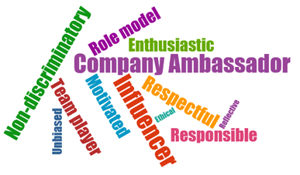How Head Light supports police forces with requirements of the NTDS
Back in January, the College of Policing announced its National Talent Development Strategy (NTDS) t...

The roll-out, implementation, and bedding in of the competency framework is the next stage and can take just as long, if not longer, than designing the framework in the first place.
Here are our top tips for bringing your competency framework to life.
Your competency framework will fall flat if you expect that an all-staff email, town hall meeting and a 30-minute session with your managers is going to get everyone on-board with the new framework. The roll-out will take time, will be multifaceted and will, in some cases, be repetitive. Start off by appointing a project manager to plan and oversee the project.
If you are in a business with geographically-based HR or business unit-based HR, you will have already involved your HR leaders to consider specific needs and to hear any concerns. Now is the time to set up 1 to 1 meetings to develop specific plans of action for implementation, recognising that different HR leaders will shape and tailor the core message and benefits.
Your HR team members will have been involved in developing the framework, but, before you roll it out across the organisation, take time to make sure that they all understand the rationale for, and the final structure of, the framework. They will be the first port of call for managers and employees with questions and queries and they need the confidence and knowledge to field these. Make sure they also understand how the implementation will take place, the implications for their current talent management activities, and planned future activities.
Bring your HR leaders together and develop core toolkits for them to take, adapt and use within their own parts of the business. It will ensure that, even if HR resources are tight, your HR teams will have the fundamentals in place and, for those who have the resources and need, can tailor the content offered to employees and managers to reflect the specifics of their own business unit or department.
Our experience working with clients shows that time and again, those organisations that invest in the planning and implementation of a communications plan solidly embed their competency framework.
Be aware that this is a long term activity. There can be no one-hit activity; tell your employees time and again about how the framework impacts their current and aspirational roles. Show them how it guides what behaviours you are looking for, and those you are not.
Build into your communications plan how you will shape the message and the content to each audience. This requires more time but leads to greater acceptance by the recipients as they feel and understand the relevance to them as members of the organisation.
Think about what managers need to know as compared to individual employees. There will be very real differences.
Think about the language used. One of our clients avoids using the word ‘competencies’ with those employees not likely to have heard the term before and opts for the more common term ‘behaviours’.
Most of our clients start with a comms list of all staff emails, department meetings and a section on the company intranet to share news about the new framework. Make sure all employees can access the message. Think about recorded videos by senior leaders, live and recorded webinars, in-person presentations, written communications, and Q&A sessions.
Start at the beginning of your talent activity. Make sure that you build your new competencies into your job descriptions and role profiles. You want potential applicants to understand what it takes to be successful in your organisation and you want your managers and your candidate assessment to be measuring the right behaviours, skills and attitudes.
You may need to help your current employees acquire and develop new competencies. With your new competency framework in place, remember to revisit the content of your current talent development programmes, as well as weaving it into new programmes as you design them.
You will want your employees to truly understand what it takes to be successful in your organisation. Where better to help them gain this understanding than as part of the performance conversation. If you are using performance review software then be sure that your system can accommodate your competency framework.
With the rest of the organisation now knowledgeable in and aligned with the new competency framework, make sure that your talent and HR focus is on developing the competencies needed to take the organisation forward.
We work with clients to develop, update and roll-out their competency frameworks. One such client is Logicalis.
If you want to explore how we could support you to design and implement a framework of behaviours to take your organisation forward, then get in touch.
You may also be interested in reading our article in which we look at the role of competency frameworks within talent management.
And a further article about bringing competencies back to life.
Back in January, the College of Policing announced its National Talent Development Strategy (NTDS) t...
The growing external pressures on fire and rescue services are vast, with increasing operational dem...
Employee engagement is about how enthusiastic and connected people feel about where they work. It go...